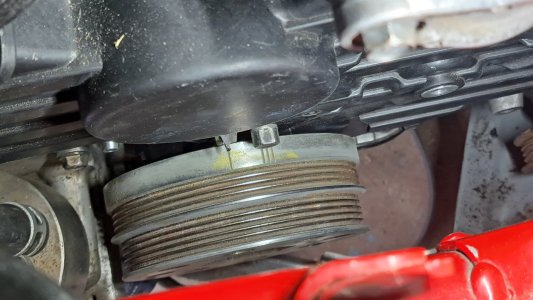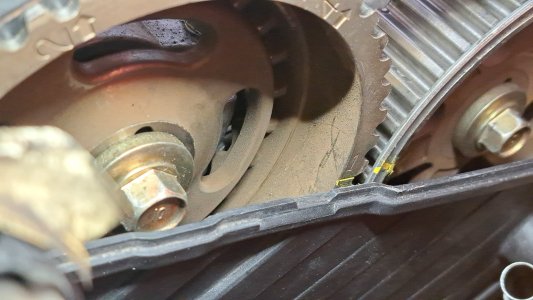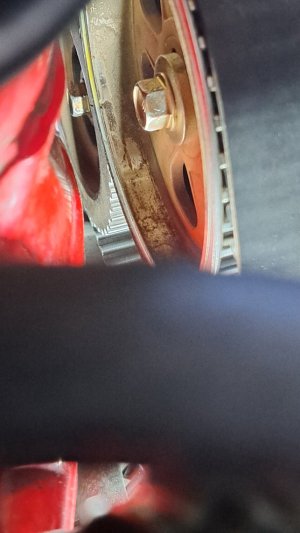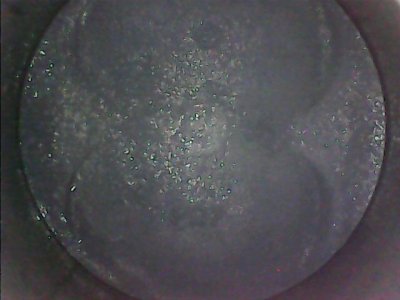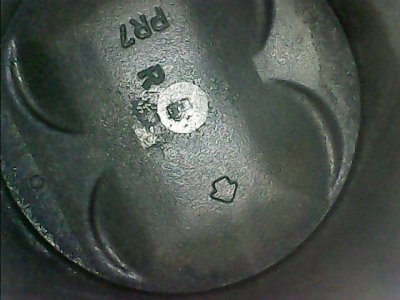Those look terrible lol. I'm curious to see how the car does now that they are clean.
Cranks but won't start
- Thread starter e9coupe
- Start date
I was glad to see bad numbers. I have plans tonight and almost feel like canceling just to test the injectors in the car.Those look terrible lol. I'm curious to see how the car does now that they are clean.
Got the injectors in. Still runs like shite! Yippee. I have a fuel pressure gauge on the way to check pressure but... WTH.
Check the pressure to rule it out; but, sad to say it is probably time to revisit the valve timing.
I'm with @Old Guy. It really doesn't sound like a fuel issue, it is possible though unlikely.
Despite your leak down results I'd check the indexing of the crank and cams. Make double sure the crank is not 180 out of phase.
You can keep your gauge hooked up to the port on the fuel filter. Depending on tool config, if it has a long hose, you might consider taping it to the back window so you can watch what is going on from inside the car.
Verify your crank angle sensor. You might have to get "middle school" on it and get a data logging setup. MotorMouth has published a way to get/watch real time data.
Despite your leak down results I'd check the indexing of the crank and cams. Make double sure the crank is not 180 out of phase.
You can keep your gauge hooked up to the port on the fuel filter. Depending on tool config, if it has a long hose, you might consider taping it to the back window so you can watch what is going on from inside the car.
Verify your crank angle sensor. You might have to get "middle school" on it and get a data logging setup. MotorMouth has published a way to get/watch real time data.
To recap recent events... the motor was running decent but had the roughness that kind of showed in the video. I took it for a drive up and down the street and it ran the same in first gear and not under load. The first time I accelerated hard the motor misfired way worse, like it does now, and now misfires badly with or without load.
Since then I've rechecked timing marks, done a leak down, compression test (since I was already there), had the injectors cleaned/calibrated and made sure the battery cables were clean and connected well.
Heavy misfiring after a load could be fuel but I usually go to ignition first. There are six new coils and plugs, ignitor has been replaced and a friend probed the signals from the ECU on his hand scope and said it looked good. I'll look into the crank angle sensor procedure.
Since then I've rechecked timing marks, done a leak down, compression test (since I was already there), had the injectors cleaned/calibrated and made sure the battery cables were clean and connected well.
Heavy misfiring after a load could be fuel but I usually go to ignition first. There are six new coils and plugs, ignitor has been replaced and a friend probed the signals from the ECU on his hand scope and said it looked good. I'll look into the crank angle sensor procedure.
Last edited:
If you are absolutely 100% confident that the valve timing is not an issue then I would check the base ignition timing as per the service manual.
You can get tail pipe adapters for O2 sensors which allow you to sample on the go with a wide band sensor. Doing that might give you some idea as to whether you are having a fueling issue of some kind. You can also measure the voltage that that your existing narrow band sensors are reading; but, narrow band sensors are so no linear that it pretty much just tells you that you are above 14.7 or you are below 14.7. It would point out differences between the front and rear banks and would probably tell you whether you were really really lean.
You can get tail pipe adapters for O2 sensors which allow you to sample on the go with a wide band sensor. Doing that might give you some idea as to whether you are having a fueling issue of some kind. You can also measure the voltage that that your existing narrow band sensors are reading; but, narrow band sensors are so no linear that it pretty much just tells you that you are above 14.7 or you are below 14.7. It would point out differences between the front and rear banks and would probably tell you whether you were really really lean.
I have test pipes with an O2 sensor bung and a LM-1 for situations like this. This [prior to having kids] was part of my test rig for my CTSC.
This looks to be modern version as all my tools are now vintage.

 www.innovatemotorsports.com
www.innovatemotorsports.com
FYI, Legend injectors look the same as NSX but run super lean. I tried them initially when getting my original injectors cleaned and the NSX was my daily driver. I didn't get past the idle stage and just borrowed until my original injectors came back from RC.
This looks to be modern version as all my tools are now vintage.

LM-2: Handheld Digital Wideband Air/Fuel Ratio Meter & Datalogger, Single O2, Complete Kit
LM-2 AFR Kit w/case
FYI, Legend injectors look the same as NSX but run super lean. I tried them initially when getting my original injectors cleaned and the NSX was my daily driver. I didn't get past the idle stage and just borrowed until my original injectors came back from RC.
This was the tail pipe adapter thing that I was thinking of which allows you to use any wide band sensor for tail pipe AFR measurements. Some of the tips on the NSX exhaust system that really flare out wide may render the adapter ineffective.
Fuel pressure is good so fuel is eliminated as the problem. I couldn't get an inductive timing light to work on the service loop yesterday. Any trick to it? I guess I should test the timing light on another motor just to make sure it's working. 
I wonder if your ECU is bad?
The list is getting really short and that's on it.I wonder if your ECU is bad?
If the engine is running, the ECU is definitely not 100% bad. If you have probed the injector and ignition outputs from the ECU and they all appear to be switching when the engine is running (no dead cylinders) then the probability weights on the side that the ECU is OK.
The ignition testing service loop is low voltage (12v) between the negative terminal of the #1 coil and the switching transistor in the ignitor. If you look at some inductive timing lights, specifically those meant to work by clamping the inductive pick up over the #1 high voltage lead between the distributor and spark plug, they will have an arrow on the pick up indicating that it should be pointed at the spark plug. The triggering circuit in some timing lights is sensitive to the orientation of how the pick up is aligned. If incorrectly aligned some will not work at all, some give flakey results and some are insensitive to the orientation of the pick up. It is a good idea to check your timing light on a running engine to confirm that it is not defective. If it tests out OK, try flipping the orientation of the pick up back and forth to see if that resolves the problem. Also, the loop is not huge and if you have a large pick up the jaws of the pick up may not be closing completely. If the jaws of the pick up are not closing completely around the service loop that will make for a weak trigger signal which may not fire the timing light.
Since you were messing with the ignitor, check the grounding connector G103 which connects to the 8 pin connector on the ignitor. Check the actual grounding lug (G103) and check the continuity of the pins in the C123 8 pin connector which connect to the lug. In fact, check all the terminals on the ignitor for signs of corrosion. 10 years ago it was not unheard of for people to have ignition problems because of flakey electrical problems with the ignitor connections / grounding. This problem seemed to be more common on owners who obsessed about having a clean engine.
There is a condenser on the ignition coil +12 supply for radio noise suppression. If the condenser becomes iffy, it can cause problems for the ignition system. Unfortunately, testing the condenser requires a rather uncommon tool. The connector for the condenser gives you access to the 12v supply to the coils so you can probe at that connection to confirm that the coils have a healthy 12v supply.
I will note that none of this really jives with your circumstances where the engine was running fine and then wasn't running fine. However, you now seem to be in the process of eliminating all possible causes so this would be part of the process of ruling out an ignition problem.
If you can get the ignition timing light working, you can do the basic test in the service manual which is checking the timing at idle which should be 15+/- 2 deg. The service manual gives no guidance for checking the timing at any other engine operating condition.
The ignition testing service loop is low voltage (12v) between the negative terminal of the #1 coil and the switching transistor in the ignitor. If you look at some inductive timing lights, specifically those meant to work by clamping the inductive pick up over the #1 high voltage lead between the distributor and spark plug, they will have an arrow on the pick up indicating that it should be pointed at the spark plug. The triggering circuit in some timing lights is sensitive to the orientation of how the pick up is aligned. If incorrectly aligned some will not work at all, some give flakey results and some are insensitive to the orientation of the pick up. It is a good idea to check your timing light on a running engine to confirm that it is not defective. If it tests out OK, try flipping the orientation of the pick up back and forth to see if that resolves the problem. Also, the loop is not huge and if you have a large pick up the jaws of the pick up may not be closing completely. If the jaws of the pick up are not closing completely around the service loop that will make for a weak trigger signal which may not fire the timing light.
Since you were messing with the ignitor, check the grounding connector G103 which connects to the 8 pin connector on the ignitor. Check the actual grounding lug (G103) and check the continuity of the pins in the C123 8 pin connector which connect to the lug. In fact, check all the terminals on the ignitor for signs of corrosion. 10 years ago it was not unheard of for people to have ignition problems because of flakey electrical problems with the ignitor connections / grounding. This problem seemed to be more common on owners who obsessed about having a clean engine.
There is a condenser on the ignition coil +12 supply for radio noise suppression. If the condenser becomes iffy, it can cause problems for the ignition system. Unfortunately, testing the condenser requires a rather uncommon tool. The connector for the condenser gives you access to the 12v supply to the coils so you can probe at that connection to confirm that the coils have a healthy 12v supply.
I will note that none of this really jives with your circumstances where the engine was running fine and then wasn't running fine. However, you now seem to be in the process of eliminating all possible causes so this would be part of the process of ruling out an ignition problem.
If you can get the ignition timing light working, you can do the basic test in the service manual which is checking the timing at idle which should be 15+/- 2 deg. The service manual gives no guidance for checking the timing at any other engine operating condition.
Got a little time to look at the car over the weekend with my friend and his snap-on timing light. The service loop worked with his and we see #1 bouncing around. It showed further down the pulley most of the time then would quickly jump to TDC for one pulse then back down. Hard to get the motor to operating temp though since it runs really poorly. He's coming over with his hand scope again to check signals.
If the RPM is bouncing the ignition timing will bounce. You need to try and estimate the amount of angle bounce by applying marks to the pulley at 10 deg intervals - not the easiest thing to do.
Is there any chance that the cam and crank sensor unit got wacked (misalignment or loose) or that you have a bad electrical connection there? The sensor unit tends to look like crap with potting compound oozing out; but, that generally seems to have no affect on its performance. Check the wiring pigtail where it enters the potting compound to see if it looks like the wires are broken at that point.
Is there any chance that the cam and crank sensor unit got wacked (misalignment or loose) or that you have a bad electrical connection there? The sensor unit tends to look like crap with potting compound oozing out; but, that generally seems to have no affect on its performance. Check the wiring pigtail where it enters the potting compound to see if it looks like the wires are broken at that point.
Now searching for nearest cliff!
Working on the car very slowly, and I think that may be why I'm making dumb mistakes. Last update was the motor running badly after a big load on it while driving. I thought I checked TB marks afterwards but I guess I just did all the other tests instead. Once I took the covers off I found the belt had jumped three or four teeth on the crank, and, it was also off one tooth on the rear intake sprocket. The crank slip happened when the load was put on it but I think the intake might have been off all along, which could explain that slight roughness before. There was a rogue mark on the sprocket that I think I used to check with. Those marks are really hard to see with just the valve covers off.
Anyway, I realigned the belt, checked it ten times and had my friend check it, then started the motor. Runs like crap, but different than before. I immediately took the valve covers back off and checked timing marks and they're right on. Compression test shows 200-210 cold without WOT and a vacuum gauge is steady but follows rpm up and down a little bit at idle. It's a heavy misfire but now hunts for rpm somewhat. Like fuel/air adjusting but just slightly. I thought maybe the ecu temp sensor might be contributing but it ran ALMOST good prior to the belt slipping.
Of course it could be damaged valves but it doesn't feel like it when running and you'd think it would show in compression or vacuum. I'll try to post a video.
Working on the car very slowly, and I think that may be why I'm making dumb mistakes. Last update was the motor running badly after a big load on it while driving. I thought I checked TB marks afterwards but I guess I just did all the other tests instead. Once I took the covers off I found the belt had jumped three or four teeth on the crank, and, it was also off one tooth on the rear intake sprocket. The crank slip happened when the load was put on it but I think the intake might have been off all along, which could explain that slight roughness before. There was a rogue mark on the sprocket that I think I used to check with. Those marks are really hard to see with just the valve covers off.
Anyway, I realigned the belt, checked it ten times and had my friend check it, then started the motor. Runs like crap, but different than before. I immediately took the valve covers back off and checked timing marks and they're right on. Compression test shows 200-210 cold without WOT and a vacuum gauge is steady but follows rpm up and down a little bit at idle. It's a heavy misfire but now hunts for rpm somewhat. Like fuel/air adjusting but just slightly. I thought maybe the ecu temp sensor might be contributing but it ran ALMOST good prior to the belt slipping.
Of course it could be damaged valves but it doesn't feel like it when running and you'd think it would show in compression or vacuum. I'll try to post a video.
The manifold air temperature correction generally has a smaller effect on fuel mixture. Enough to cause an emission test failure on HC and hurt your fuel consumption; but, not enough to screw up engine operation. A problem with the coolant temperature sensor can cause problems if it reads low and keeps the engine in warm up mode even though it is hot and prevents closed loop operation. If it is stuck in warm up mode that will eventually show up on the plugs. However, being stuck with a rich fuel mixture typically does not cause misfires. Misfires usually come from lean fuel mixtures.
Have you checked your plugs to see what they look like? Has the engine run long enough to come up to operating temperature? If so, use the service check connector to determine whether there are any stored DTCs. A sniffer up the tail pipe(s) might help to determine whether your fuel mixture is going seriously out of whack.
Have you checked your plugs to see what they look like? Has the engine run long enough to come up to operating temperature? If so, use the service check connector to determine whether there are any stored DTCs. A sniffer up the tail pipe(s) might help to determine whether your fuel mixture is going seriously out of whack.
Prior to the last belt alignment all six plugs were black black. I've only run the motor for a total of 30 seconds since fixing the belt.
Black plugs suggest too rich of a mixture. I know you had your fuel injectors cleaned, and your fuel pressure is looking ok, so the last link in the loop is the ECU. It could be that the ECU is in limp mode and/or open loop, which is designed to run rich to allow the engine to keep running when the O2 sensors fail (rich is much safer than lean). Have you verified your O2 sensors are working? If you only ran the engine for 30 seconds post-belt fix, then it would not have warmed up enough for the ECU to switch over to closed loop fueling. As @Old Guy suggested, warm up the car to operating temp (rad fan comes on at least twice) and go for a short drive to see if things improve. Generally, eevn the OBD-I will throw a code for the O2 sensor if they fail, but I wonder if they still are malfunctioning somehow.Prior to the last belt alignment all six plugs were black black. I've only run the motor for a total of 30 seconds since fixing the belt.
3 to 4 belt teeth is a fairly serious problem on the NSX and I also would use a borescope to inspect your valves for signs of piston contact. Bent valves could also cause rough running, but your compression numbers suggest they are ok. If so, you're very lucky.
Finally, I would open up your ECU and look for signs of tampering/tuning. A shoddy chip job could be causing the problem as well.
I'll try to run the motor long enough to warm up. ECU has a Dinan chip but all looks very clean and nothing stands out with close magnified inspection.
I'm still preparing myself for bent valves.
I'm still preparing myself for bent valves.
That would have been a useful detail from the start. Is the engine modified? If not, what purpose is the Dinan chip as there is little to no value in modifying fuel and ignition maps on a stock engine. If the engine is modified, then that is another missing detail.I'll try to run the motor long enough to warm up. ECU has a Dinan chip but all looks very clean and nothing stands out with close magnified inspection.
I'm still preparing myself for bent valves.
Dirty plugs are a huge diagnostic red flag. If your spark plugs are sooty black it is time for a trip to the garbage can. They will almost certainly be contributing to the crappy operation. Rich fuel mixtures generally do not cause misfire; but fouled plugs will misfire. Put new plugs in and see if you can get it running long enough for it to come up to operating temperature at which point it should go into closed loop. At that point, if you have fuel mixture violations the ECU may then set some error codes which may give you some idea what is going on. Big however, your O2 sensors may be royally screwed. You can pull them out and examine and you can measure he sensor voltage to see if they appear to be alive; but, given your current problems and the fact the car sat for so long I am inclined to say just replace them.
After a little engine operation, pull and examine your new plugs. If they are already turning dark brown / black you know you have a fuel mixture problem. I don't know what the Dinan chip does; but, if new plugs and replacement O2 sensors don't resolve the problem finding a replacement ECU with an OEM tune would be my preferred starting point.
I am now kind of out of this particular diagnostic round table because all of my advice is pretty much predicated on stuff being OEM. Once it is modified it creates too many unknowns for me to provide useful advice.
Agree 100% with @Old Guy. I'd pull that garbage Dinan chip out of there and replace with an OEM EPROM. @MotorMouth93 may be able to burn you an OEM chip so reach out to him.
There are two issues we see with aftermarket chips on the NSX- especially crusty old ones like the Dinan, which were developed in the 1990's. Issue number 1 is that the tune is bad. These chips were tuned on a single NSX on a single day and then distributed all over the US. Your NSX might not like the fuel and timing adjustments that worked on some guy's NSX at the dyno in 1994. Or it could be that the 20+ year old EPROM chip got corrupted somehow and is wreaking havoc with your fueling.
Issue number two is that we see poor installation jobs. A loose connection or bad solder joint on the ZIF socket can cause all kinds of weird ECU behavior. I would pull that Dinan chip and carefully examine the ZIF socket (including the back of the ECU board) for any signs of cracks or poor solder joints.
A quick way to check this is to find a local owner with a OEM ECU that you can plug into the car and test run. If all the problems go away, there's your solution. I would have a professional electrician shop remove the chip and ZIF socket, and then solder in a new ZIF and install an OEM EPROM chip. That way, you're back to OEM.
Before you do any of this, however, change those plugs. You can just buy the cheap Champion ones from Autozone for testing purposes and then swap out with the $$ double-platinum Denso/NGK ones once it's fixed.
There are two issues we see with aftermarket chips on the NSX- especially crusty old ones like the Dinan, which were developed in the 1990's. Issue number 1 is that the tune is bad. These chips were tuned on a single NSX on a single day and then distributed all over the US. Your NSX might not like the fuel and timing adjustments that worked on some guy's NSX at the dyno in 1994. Or it could be that the 20+ year old EPROM chip got corrupted somehow and is wreaking havoc with your fueling.
Issue number two is that we see poor installation jobs. A loose connection or bad solder joint on the ZIF socket can cause all kinds of weird ECU behavior. I would pull that Dinan chip and carefully examine the ZIF socket (including the back of the ECU board) for any signs of cracks or poor solder joints.
A quick way to check this is to find a local owner with a OEM ECU that you can plug into the car and test run. If all the problems go away, there's your solution. I would have a professional electrician shop remove the chip and ZIF socket, and then solder in a new ZIF and install an OEM EPROM chip. That way, you're back to OEM.
Before you do any of this, however, change those plugs. You can just buy the cheap Champion ones from Autozone for testing purposes and then swap out with the $$ double-platinum Denso/NGK ones once it's fixed.
I get the concern about the old Dinan chip, and everything I've read about them says they don't do much, if anything, over OEM. All I can go on is how it ran prior to sitting so long AND the fact that the motor ran pretty darn good with the exception of that slight misfire/vibration before the TB slip. I think that small misfire was the intake being off one tooth the whole time but obviously can't verify.
My big sticking point is the fact that it almost ran perfectly when I drove it and the belt slipped. Now the TB is where it should be so what could've changed other than valve damage?
I have a set of test plugs I pulled from a good motor at work and was the first thing I swapped after the belt slip. No change. I cleaned the new plugs that were black and after running it for a couple minutes they didn't show any change, still clean.
Sorry for any confusion but I've done so many things so many times it's all a blur now. If I'd known I would've taken notes from the beginning.
My big sticking point is the fact that it almost ran perfectly when I drove it and the belt slipped. Now the TB is where it should be so what could've changed other than valve damage?
I have a set of test plugs I pulled from a good motor at work and was the first thing I swapped after the belt slip. No change. I cleaned the new plugs that were black and after running it for a couple minutes they didn't show any change, still clean.
Sorry for any confusion but I've done so many things so many times it's all a blur now. If I'd known I would've taken notes from the beginning.
Okay, I took covers off to verify again, because it's so fun, and will start the motor again tonight with a set of new plugs. I used my cheap bore score to look at the pistons for signs of valve contact and gladly didn't see any, but, saw something interesting. The photos below show what the rear bank of pistons look like (very clean) and the front bank (carbon build up). All three rear looked the same and all three front looked the same. I think this would be a long term thing so what do you guys think? Running lean on the rear bank? O2 sensor?
BTW, I can get the rear timing cover off in about 30 seconds now not including bolts. Not something I'll add to my resume though.
BTW, I can get the rear timing cover off in about 30 seconds now not including bolts. Not something I'll add to my resume though.
Attachments
Similar threads
- Replies
- 23
- Views
- 705
- Replies
- 38
- Views
- 3K






